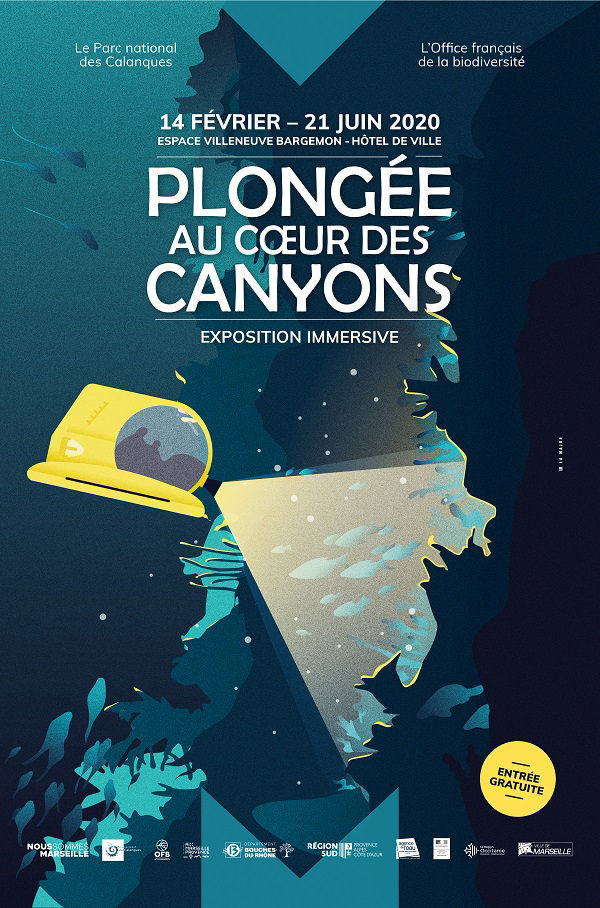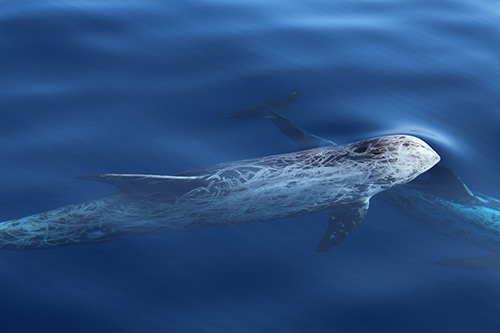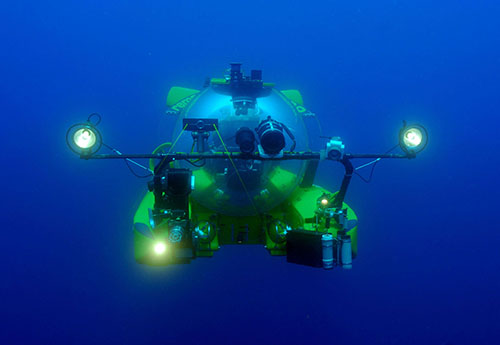With their cliffs which sometimes dive more than 1000 m, the reliefs are very rugged.
There is total darkness.
Particularly powerful currents.
And avalanches of sediment are constantly threatening.
Commander Cousteau almost was swept away by an avalanche which he set off after hitting a wall during a dive in the Toulon canyon aboard his submarine FNRS-III.
A long history Despite the little publicity given to them, underwater canyons have interested scientists and explorers for a long time.
In 1725, we already guessed their presence on a map of the underwater reliefs that Count Marsili (1658-1730) drew up from the Mediterranean.
Then, in the 19th century, it was the biologist Henri Lacaze-Duthiers (1821-1901) who sailed with fishermen to observe and draw the fauna of the canyons as they boarded their boats.
One of the most beautiful canyons in the Mediterranean bears his name.

THE CONQUEST OF FUNDS
Thanks to the technical resources made available by COMEX - a Marseilles company specializing in the conquest of the seabed, the MedSeaCan and CorSeaCan campaigns made it possible to study 35 canyons and 7 rocky banks.
A SCIENTIFIC ODYSSEY ...
The campaigns brought together teams of scientists from many disciplines.
They aimed at a homogeneous and systematic observation over a short period, in order to identify habitats, species, ecosystems and anthropic pressures.
During the mission, thousands of photos, hundreds of hours of video and several dozen samples were taken.
Thanks to this multitude of information, these campaigns are now fueling research and constitute a precious reference state for managers of marine protected areas.
DISCOVERING THE CANYONS
The underwater canyons deeply cut the continental slope and plunge towards the abyss.
There is a very dynamic current regime that feeds other marine ecosystems and promotes the presence of many species.
DID YOU SAY CANYON?

Silted and fairly deserted, or composed of steep rocks teeming with life, the 35 canyons studied during the campaigns revealed very diverse morphologies.
Some may suddenly descend, while others stretch for long kilometers before reaching the deep sea.
LIFE OASIS
The underwater canyons constitute privileged channels for the currents which circulate between the surface and the bottom.
Oxygen-rich surface waters and nutrient-laden deep waters are thus set in motion and there are amply mixed, carrying with them all the elements necessary for life.
These deep valleys therefore exert a considerable influence on the exchange of water masses and on the global marine ecosystem. Another consequence: in these deep valleys, the intense circulation of oxygen and nutrients between the surface and the bottom attracts an extraordinary fauna, which can be very abundant in places, and very diversified.
Immersed in the dark, a few hundred meters from the surface, canyons are real oases of life!
AND TOMORROW ?
Through exploration campaigns, canyons have been identified as exceptional habitats.
Now integrated into marine protected areas, they have become key areas for monitoring the marine environment and are subject to regular monitoring.
But this underwater adventure has only just begun.
Millions of cubic kilometers are still to be explored.
And other protective measures are essential.
Creation of connected marine areas, sustainable management of human activities, combating pollution at sea… there are many avenues.
The transition to sustainability requires commitment at all levels, whether individual, collective or associative, national or international ...
The construction of a new maritime citizenship is urgent. Let's act!
GUIDED TOURS
Every Wednesday, Saturday and Sunday at 2.30 p.m. School holidays: also on Tuesdays, Wednesdays, Thursdays and Fridays at 10.30 a.m. Duration: 1 hour Visit in groups of 15 people max.
Also in English and Italian on request.
Reservation recommended: www.expocanyons.fr
IMMERSIVE JOURNEY
Have you ever set foot in a submarine to see the abyss with your own eyes?
A virtual reality headset is made available to visitors at the end of the exhibition, to propel them onto the rocky outcrop of the Cassidaigne canyon, 230 m deep.
A unique dive into a 3D world!
Every Wednesday, Saturday and Sunday from 10 a.m. to 12:30 p.m. and from 4:30 p.m. to 6 p.m. - Duration 2 minutes.
WORKSHOPS AND MEETINGS
Workshops for young people, guided tours provided by mission scientists who come to share their taste for discovery, meetings and debates with citizens committed to protecting the oceans, readings and creative workshops with artists who are passionate about canyons…
Plunged into the heart of the canyons, these are also privileged - and free - meetings to cultivate your curiosity and bring alive the debate and the commitment of each.
General public - Wednesday, Saturday and Sunday at 2:30 p.m. - Duration: 1:30 School holidays: also Tuesday, Wednesday, Thursday and Friday at 4 p.m. - adapted duration Program and reservation: www.expocanyons.fr
THE CALANQUES NATIONAL PARK THE FRENCH BIODIVERSITY OFFICE
All committed to nature Created in 2012, the Calanques National Park is the only urban national park in Europe.
This coexistence of the city and an exceptional natural space is the melting pot of many challenges, as well as a great opportunity to seek and develop solutions for the future in favor of biodiversity.
Calanques National Park also has the distinction of being both terrestrial and marine.
With 43,500 hectares classified in its marine core, benefiting from strong protection measures, its marine vocation is essential. Composed of a great diversity of natural habitats, the National Park is home to more than 200 protected and heritage species.
One of the area's major markers of biodiversity is the underwater canyons of Cassidaigne and Planier. www.calanques-parcnational.fr https://www.facebook.com/ParcNationalDesCalanques/
The scientific community is unanimous: the disappearance of many species and the degradation of ecosystems are experiencing unprecedented acceleration.
The rate of species extinction is 100 to 1,000 times higher than the natural
rate observed in the past 10 million years!
Since January 1, 2020, the French Office for Biodiversity (OFB) is the new State operator
responsible for ensuring the preservation and restoration of biodiversity.
It takes over the missions of the French Agency for Biodiversity (AFB) and the National Office for Hunting and Wildlife (ONFCS).
Facebook
|


